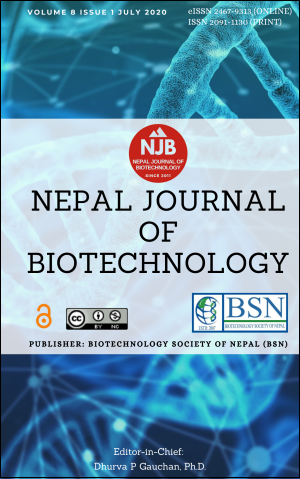Standardization of Ayurvedic Drug- Nyctanthes arbor-tristis, Hippophae salicifolia, Ocimum tenuiflorum and Reinwardtia indica and Combined Herb-Herb
DOI:
https://doi.org/10.3126/njb.v8i1.30208Keywords:
Physicochemical, Polyherbal, Powder, Polyherbal formulation, Single, Herb-Herb combination, FlavonoidsAbstract
The herbal medicines have reached extensive acceptability as therapeutic agents for various clinical diseases due to global demand. Therefore, standardization is the essential and initial step to drug development. It is for the establishment of consistent biological activity, a consistent chemical profile and biomarker identification. It improves the safety and efficacy of herbal medicine to provide the best herbal medicine to society and increase popularity rather than non-standardized extracts. In addition, it is essential to practice or maintain a quality assurance program for the production and manufacturing of herbal medicine that includes the basis of organoleptic characters and photomicrographs, physicochemical, proximate analysis phytochemical evaluation and quality control analysis and order to assess the quality of drugs, based on the concentration of their active principles. WHO has provided specific guidelines for the assessment of the safety, efficacy and quality of herbal drugs as a prerequisite for global harmonization and of utmost importance. In the present study, the herbal extracts were cleaned, dried in the shade and powdered by passing through the sieve as per the method described in the standard protocol. An overview covering various techniques employed in the extraction and characterization of Nyctanthes arbortristis, Hippophae salicifolia, Ocimum tenuiflorum and Reinwardtia indica, standardization is reported in this study. The obtained data would be very significant for future clinical aspects, as the bioactive molecules present in the extracts may exhibit synergistic effect with other bioactive compound and show a better therapeutic value. Thus, this study provides standardized and therapeutically potential data of active polyherbal formulations for the different ailments.
Downloads
Downloads
Published
How to Cite
Issue
Section
License
Copyright Notice:
The manuscript submitted to NJB must be an original contribution, not previously published and should not be under consideration for publication elsewhere. When the manuscript is accepted for publication, the authors agree to automatically transfer the copyright of the article to the publisher. It should grant permission to any third party, in advance and in perpetuity, the right to use, reproduce or disseminate your article, according to the NJB copyright and license agreement.
Authors transfer copyright to the publisher as part of a journal publishing agreement but have the rights to: Share their article for Personal Use, Internal Institutional Use and Scholarly Sharing purposes, with the NJB applies the Creative Commons Attribution-NonCommercial CC BY-NC license to all the works we publish after Jun 2020 (Before it was CC BY-NC-ND). Under this license, authors agree to make articles legally available for reuse, without permission or fees, for virtually any non-commercial purpose. Anyone may remix, adapt, and build upon your work non-commercially, and although their new works must also acknowledge you and be non-commercial, they don’t have to license their derivative works on the same terms. More details on CC BY-NC refer to its Licence Deed and Legal Code.






